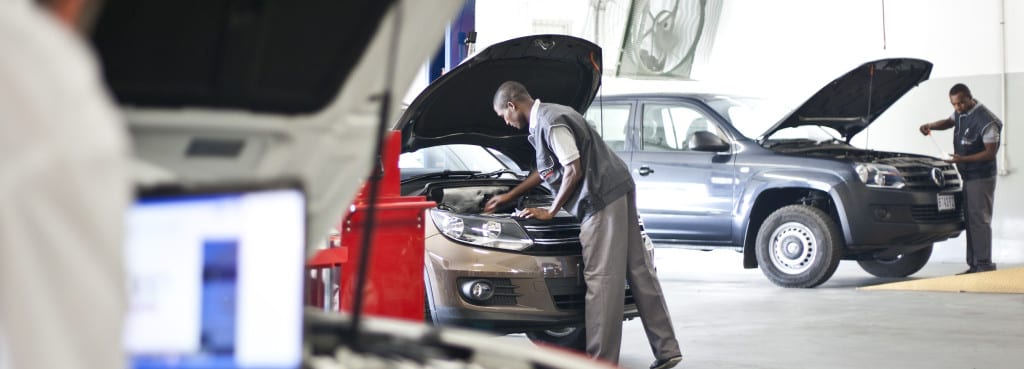Okay, so you’re not ready to commit to an electric or hybrid vehicle, but you are concerned about your carbon footprint and the impact your car has on the environment.
You don’t have to drive an alternative-fuel vehicle to enjoy a greener, more socially conscious, automotive existence.
A local service department can provide you with some strategies to help you engage in eco-friendly and efficient driving without pulling you away from the pump.
It’s All About Service
The key to greener driving comes down to commitment, no matter what you drive.
A commitment to routine maintenance is crucial when it comes to fuel efficiency. Your vehicle, properly maintained, will demonstrate improved efficiency when it comes to fuel consumption and your car’s overall performance.
Improved fuel efficiency equals better gas mileage, which of course means fewer stops at the gas station, and therefore, fewer fill ups. Actually, you can improve your fuel economy by 4 percent just by scheduling a tune-up.
That savings jumps to a whopping 40 percent if you make a serious repair, such as replacing an oxygen sensor or spark plugs. The less you fill up, the less fuel you’re using, which is better for the environment overall, extending an already limited, nonrenewable, natural resource.
Lest we forget, improved fuel economy is better for your wallet. And let’s be honest, isn’t it easier to get onboard with the environment when you can save a few bucks in the process?
Of course it is.
Just because your heart’s in the right place, doesn’t mean your money can’t be, too.
Oldies, but Goodies
An added bonus to proper car maintenance is a longer life.
No, not for you. For your car.
Regular upkeep of your car will help extend its life, keeping it on the road longer, and preventing you from unnecessarily purchasing a new car.
This is an added boon for the environment because fewer cars on the road equals less emissions, and less emissions means cleaner air.
Now obviously just because you decide not to purchase a new car every few years, it’s not like the automotive manufacturers are going to slow production.
So, you might wonder, what’s the point?
Fair enough.
Particularly when you consider that some new cars are far more environmentally-friendly right off the production line than their older counterparts.
It’s all about innovation and innovation is, by definition, new.
New cars will still be released often, but increasingly even one-hundred percent fuel-powered cars offer greater technological innovation with respect to the environment.
For example, many new cars are categorized as PZEV, or Partial Zero Emissions Vehicles, which mean that they produce zero evaporative emissions from their fuel systems and meet SULEV (Super Ultra Low Emission Vehicle) standards.
Depending on where you live, you may be entitled to a tax incentive for driving a certified PZEV.
Regardless of age and innovation, your car’s maintenance is one of the biggest factors in your control when it comes to enhancing your car’s environmentally-considerate existence.
Drop the Weight
While you’re at it with the car maintenance, take the time to clean out the inside of your car and trunk.
Rid those cabins of any unnecessary items, which are adding weight to your car, making the ride more sluggish and using excess fuel. The more weight a vehicle has to haul, the more compromised it’s fuel economy will be.
So, de-clutter and enjoy a lighter ride, longer.
Recycle Those Fluids
Great, you’re maintaining your car on a regular basis and, as it turns out, you’re one of those DIY folks when it comes to oil changes.
Knock yourself out! But make sure that when you dispose of the used oil you do it properly. Or recycle it!
According to the EPA, the Environmental Protection Agency, if all DIY oil changers recycled the used oil from every oil change, the refined oil could be used to power 50 million cars annually.
The EPA estimates than an average four million people reuse their motor oil to lubricate other machinery and equipment.
Not sure how to recycle your used motor oil? Consult the EPA’s Used Oil Management Program.
Of course, a big benefit of scheduling oil changes with a trusted mechanic is that they are already equipped to recycle the spent oil, keeping it from spilling into the environment and possibly contaminating streams and soils. You can also find oil change coupons that will save you money, and make getting the work done professionally even more appealing.
But either way, as long as the used oils are recycled, that’s what counts.
If they cannot be recycled, make sure that you dispose of them properly.
The same holds true for tires, batteries, and any other car components that you no longer need.
Maniac!
Ever heard that when you were behind the wheel? Believe it or not – the way you drive has environmental implications.
We’re not talking about tossing that Big Mac wrapper out of the window while bombing down some pristine backroad. This is not about litter. But you shouldn’t do that, anyway.
The way you drive, just like the way you maintain your vehicle, has a lot to do with your car’s fuel efficiency. Certain types of driving sins like excessive speed, sudden stops, and unnecessary idling, will decrease your fuel economy.
And the numbers prove it.
For most cars, fuel efficiency drops when you drive over 50 miles per hour. It’s a basic math equation. For every 5 mph over 50 mph, your car’s fuel efficiency decreases by $0.24 per gallon.
When it comes to hard braking and rapid deceleration, fuel efficiency can fall by 33 percent, with respect to highway driving and five percent for city driving. Protect your mileage, the environment, and your wallet by following the speed limit, maybe even give cruise control a try. After all, it’s there for a reason.
Stay alert to avoid sudden, harsh stops.
Depending on your climate, avoid using your car’s air conditioning system or use it only when you absolutely must to avoid melting.
Try parking in shadier spots or invest in a reflective windshield shade to keep your car cooler, which will require less A/C to cool the cabin down when you’re ready to go somewhere.
Or just cool off the old-fashioned way, roll down your windows.
Overestimating Electric Cars
A recent study titled, “Life Cycle Air Quality Impacts of Conventional and Alternative Light-Duty Transportation in the United States,” conducted by the Proceedings of the National Academy of Sciences of the United States of America (PNAS), examined the pollution resulting from the electricity used to power alternative vehicles.
Depending on how the electricity is produced, an electric car can actually contribute to air pollution.
If an electric car is powered by natural gas, wind, water, or solar power, the air quality improves.
However, corn ethanol or coal actually pollutes the environment. Coal generates about 39 percent of the electricity used in the United States.
If you drive an electric car whose electricity is created by coal, you’re actually driving a car that is 3.6 times more damaging to the environment than a conventional, gasoline-powered vehicle.
An estimated one-third of all electric vehicles currently on the road are powered by coal-generated electricity. Driving a car which runs on gas is actually the cleaner and greener choice.
Who knew?
Making some simple decisions and creating new habits is the key to taking your car from gas-guzzler to green machine.






